Vol 4 No. 38 TROPIC LIGHTNING NEWS September 22, 1969
Index
| Unit Page | Unit Page | Unit Page | Unit Page |
| 2/12 1 | 2/14 8 | 2/27 Photo 6 | 3/13 Arty 3 |
| 2/12 3 | 2/14 8 | 2/34 Armor 1 | 3/13 Arty 7 |
| 2/12 6 | 2/22 1 | 2/34 Armor 1 | 3/13 Arty Photo 8 |
| 2/14 Photo 3 | 2/22 6 | 2/34 Armor 3 | 3/27 2 |
| 2/14 3 | 2/22 8 | 2/34 Armor Photos 4 | 4/23 1 |
| 2/14 Photo 3 | 2/22 Photo 8 | 25th Avn 7 | 4/23 Photo 1 |
| 2/14 7 | 2/27 3 | 3/4 Cav 7 | 4/23 8 |
| 2/14 7 |
Lightning Remains King of the Hill
Tomahawks Chop up NVA Around Nui Ba Den Again
BULLETIN
TAY NINH - A combined force of Tomahawks of the 4th Battalion
(Mechanized), 23d infantry and soldiers of the 7th ARVN Airborne Regiment
tangled again with the communist denizens of Nui Ba Den the morning of Sept. 11,
with the usual disastrous results for the enemy. The infantrymen,
supported by artillery and light-fire teams, killed 49 NVA soldiers after a
Tomahawk point element spotted movement at the base of the mountain. The
contact brought to more than 100 the number of enemy soldiers killed by the
Tomahawks and their allies near the mountain in less than a week.
By PFC Sam B. Dixon
TAY NINH - “AK-47’s were cracking all around us. We
attempted to return to our laager site, but the fire was so heavy we were forced
to seek cover. We threw in more counter fire, returned and secured our
objective.”
Those are the words of Sergeant Lynn A. Miller of Wichita, Kan.,
recounting action in which men of Alpha and Charlie Companies, 4th Battalion
(Mechanized), 23d Infantry, killed 57 enemy soldiers in the southeast sector
surrounding Nui Ba Den.
Early in the day, the 4/23d Tomahawks had set out on a combined
operation with the 688th Vietnamese Regional Forces Company. Their
mission: reconnaissance-in-force.
Intelligence reports had suggested that a company-sized NVA element
had been spotted in the area and had disappeared into the rocks and jungle at
the base of the mountain.
While establishing a defensive position, Charlie Company and the
688th RF Company began receiving incoming 82mm mortar rounds from the mountain.
All rounds impacted outside the laager site and caused no damage.
Immediately, the Tomahawks returned fire with their own mortars and called in
artillery and light fire teams.
MOVEMENT WAS observed in the banana groves at the base of the
mountain and again the allied position received incoming rounds. The
Tomahawks again countered this time with organic fire, light fire teams, artillery and
gunships.
The Tomahawk company’s first platoon moved out on foot and
hadn’t gone more than 100 meters into the bananas when it received heavy
rocket-propelled grenade (RPG) and small arms fire. The platoon dispersed,
but later regrouped and moved deeper into the enemy position.
Sporadic fire continued until 3:00 p.m. By dusk the Tomahawks
had counted 30 enemy dead. Next day, Alpha Company of the Tomahawks moved
into the area and established contact with the enemy. Between the two
companies, 57 enemy died in the two days of battle.
| FIREPOWER, BUT NO DEMONSTRATION - Mechanized infantrymen from the 4th Battalion, 23d Infantry Tomahawks put it to enemy soldiers near the base of Nui Ba Den. (PHOTO BY PFC SAM DIXON) | 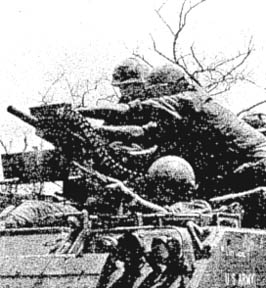 |
Armor Hits Sanctuary
By SP4 Carl Detrick
TAY NINH - The 2d Battalion, 34th Armor is rapidly convincing the
enemy that there is little sanctuary in the dense underbrush and caves that
cover the rugged slopes of Nui Ba Den.
The armormen’s latest venture cost the enemy 27 dead. The
reconnaissance and tank platoons of Headquarters and Headquarters Company were
conducting a ground reconnaissance of the terrain surrounding the eastern side
of the Black Virgin Mountain. As they approached the mountain, they
observed several enemy running from a nearby banana grove into a large cave near
the base.
IMMEDIATELY, Headquarters Company commander Captain Thomas Boling
deployed Dreadnaught tracks and men on line and directed their fire onto the
enemy’s position. The ground trembled and the mountainside reverberated
as the metal monsters unleashed their lethal barrage of 90mm cannon and .50
caliber machine gun fire.
The company’s mortar platoon was then called into action.
The mortar tracks maneuvered into position directly behind the firing tanks and
soon began to pound the enemy stronghold with devastating 4.2-inch mortar
rounds.
After completely saturating the enemy’s position, the combined
elements of Headquarters Company shifted their fire onto other targets in the
vicinity of the cave.
Assessing the situation from the scene of action, Battalion
Commander Lieutenant Colonel T. G. Smith of El Paso, Tex., requested a
psychological operations team from the Tropic Lightning 1st Brigade S-5 section at Tay Ninh base camp.
BY 7:30 A.M. the team was in action and the mountain again
reverberated, but this time to the voice of an S-5 interpreter broadcasting over
load speakers.
“We explained the chieu hoi policy and urged them to rally to the
government,” said Smith. “We told them that we will not allow them
sanctuary on the mountain or any other place. What they went through today
was just a preview of events to come; everytime they see our tanks coming they
can expect the same type of punishment.”
A post-mortem of the day’s events revealed a success story of
armor versatility and firepower coupled with modern psychological warfare
techniques. Not only did the Dreadnaughts eliminate 27 enemy soldiers, but
put many questions in the minds of other enemy as to the effectiveness of Nui Ba
Den as a sanctuary as well.
| Claymore mines are a valuable weapon. If handled carelessly, however, they are capable of making you wish they’d never been invented. Always make sure the firing device is disconnected before you even think about going near the mine. If you’re not sure how to set it up, ask someone who is sure for help. If you have ever paid heed to the maxim that encourages you to act slowly but surely, do so when working with claymores. DEROS. Do it the safe way. |
Warrior Lt. Learns Pitfalls of Carelessness
By SP4 Larry Goodson
CU CHI - A Fire Brigade platoon leader nearly disappeared into a
bottomless pit recently while attempting to check out a VC spider hole.
But instead of quicksand or gravity pulling him under, it was a frightened enemy
soldier.
Airlifted into an area near the southern tip of the Boi Loi Woods,
Company A, 2d Battalion, 12th Infantry began a systematic search of a village
suspected of harboring Viet Cong.
SHORTLY AFTER sweeping the objective, elements of the 2d platoon
found evidence that confirmed enemy presence.
The first contact with the communists proved to be hair raising for
2d Platoon Leader First Lieutenant David L. Sacket when he attempted to enter a
tunnel he believed to be abandoned.
As he lowered himself feet-first into the tunnel, Sacket was
grabbed around the ankles by an NVA soldier who was determined to pull the
startled officer into his underground lair.
QUICK REACTION by Privates First Class James Byrd, Joseph
Solleri,
and Terry Lad produced a tug-o-war that resulted in the rescue of their somewhat
shaken platoon leader.
Grenades thrown into the tunnel produced one wounded detainee.
Sacket said, “I learned today that no matter how safe a hole
looks, it has to be fragged before it is investigated.”
Interrogation of the detainee by Vietnamese scouts led to yet
another VC hiding place in the immediate area, which Private First Class John L.
Raczykowski, Tygh Valley, Ore., described by stating, “It didn’t look like
anything but a big mound of dirt. We started digging into it and broke
through into an underground bunker.”
AS SOON AS the occupants realized that they had been discovered,
they emerged, armed with hand grenades, from a well-concealed trap door.
Both enemy were killed by alert security.
The operation came to a close after the Warriors had discovered an
AK-47 rifle, a quarter-pound of documents and an NVA diary. Two hundred
pounds of rice and the sight for an 82mm Chi-Com mortar were also tallied in the
day’s bag.
Enemy Unit Cut Down
Lightning Strikes Tree, VC
TAY NINH – “If a tree falls in the woods and no one is there to
hear it, does it make a sound?”
That theoretical question has been toyed with by philosophers and
students for centuries, but it never seemed quite as relevant as it did recently
for men of Alpha Company, 2d Battalion (Mechanized), 22d Infantry, and the 2d
Platoon of Alpha Company, 2d Battalion, 34th Armor Dreadnaughts.
As a Dreadnaught M-48 tank rumbled through the dense foliage of a
favorite enemy lair, Boi Loi Woods, 13 and one-half miles southeast of Tay Ninh
City, it knocked over a tree. Not only did the Americans hear the tree
fall, but so did an estimated company of Viet Cong and North Vietnamese
soldiers.
FIFTEEN ENEMY soldiers died in the ensuing battle.
“Before the tree had completely fallen,” said Private First
Class Howard A. Houston of Hope,. Ark., “they were firing rocket-propelled grenades, .51
caliber and small arms at us. We must have stumbled straight into a small
base camp because they were well dug-in.”
Alpha Company of Triple Deuce came on line as soon as the first
enemy rounds were fired. Alpha Company’s armored personnel carriers and
tanks from the 2/34th were hampered by the high concentration of craters in the
area. So with supporting fire from the Dreadnaughts, men of Alpha Company,
Triple Deuce assaulted the enemy complex on foot.
WHEN THEY STARTED receiving fire from their flank as well as their
front, they withdrew to allow artillery and air strikes to soften the area.
This was followed by helicopter gunships and then Alpha Company
moved back in.
“It was a rough battle all the way and we were tired.
We’ve done a lot of fighting in the last week,” said Specialist 4 Ronald E.
Hopkins of Belding, Mich.
Fifteen enemy died during the battle.
Page 2 TROPIC LIGHTNING NEWS September 22, 1969
Decorated
|
BRONZE STAR FOR HEROISM |
|
|
MAJ Arthur E. Solem, HHC, 2d Bde CPT Ronald J. Taylor, V Btry, 1st Bn, 8th Arty CPT John S. Regan, Co B, 2d Bn, 14th Inf CPT Robert.B. Connolly, Co A, 2d Bn, 14th Inf 1LT Robert W. Evans, A Btry, 2d Bn, 77th Arty 1LT Steven L. Donaldson, Co A, 2d Bn, 14th Inf 1LT Larry C. Hodnett, Co C, 3d Bn, 22d Inf 1LT John Mitchell, Co D, 2d B, 27th Inf 1LT William S. Wall, Co A, 2d Bn, 27th Inf 1LT James R. Krause, Co C, 3d Bn, 22d Inf 2LT Gary B. Tucker HHS, Btry, 1st Bn, 8th Arty 1SG Hugh M. Hollis, Co B, 2d Bn, 14th Inf PSG James F. Horn, C Trp, 3d Sqdn, 4th Cav SFC Harvey Black, HHC, 4th Bn, 23d Inf SSG Gary D. Doss, Co B, 4th Bn, 23d Inf SGT Donald L. LaFaive, Co A, 2d Bn, 27th Inf SGT William P. Kenison, B Btry, 2d Bn, 77th Arty SGT Edward K. Strickland, Co D, 2d Bn, 27th Inf SGT Michael A. Janowiak, Co C, 2d Bn, 22d Inf SGT Richard D. Laxson, Co B, 1st Bn, 5th Inf SGT Kenneth E. Mullin, Co C, 3d Bn, 22d Inf SGT John C. Morelli, Co C, 3d Bn, 22d Inf SGT Brian L. Crawford, Co A, 1st Bn, 5th Inf SGT James Windenwerder, Co A, 2d Bn, 12th Inf SGT Donald G. Louk, Co A, 2d Bn, 14th Inf SGT John F. Lawinger, Co B, 2d Bn, 22d Inf SGT Gerald Johnson, Co D, 2d Bn, 27th Inf SP5 Robert Craig, Co B, 2d Bn, 14th Inf SP5 Cleveland Ott, Co C, 2d Bn, 22d Inf SP4 Justin K. Anderson, Co C, 4th Bn, 9th Inf SP4 Gary L. Starbuck, Co A, 2d Bn, 27th Inf SP4 Edgar L. Otero, Co C, 2d Bn, 22d Inf SP4 James L. Schneider, Co C, 2d Bn, 2d Inf SP4 William E. Turner. Co C, 2d Bn, 22d Inf SP4 Larry R. Goethe, Co C, 3d Bn, 22d Inf SP4 Max A. Calhoon, Co A, 2d Bn, 27th Inf SP4 David L. Lemmer, Co C, 2d Bn, 22d Inf SP4 Lowell D. Vickers, Co C, 2d Bn, 22d Inf |
SP4 Domingo Munoz, Co B, 125th Sig Bn SP4 Robert R. Dallas, Co C, 3d Bn, 22d Inf SP4 Vernon T. Ota, Co C, 2d Bn, 22d Inf SP4 James D. Homan, Co A, 2d Bn, 14th Inf SP4 Chris H. Ritchie, Co C, 2d Bn, 12th Inf SP4 Duane K. McIver, Co C, 2d Bn, 12th Inf SP4 Thomas J. Barker, Co A, 2d Bn, 14th Inf. SP4 Thomas Feldman, Co A, 2d Bn, 14th Inf SP4 Eddie C. Crowe, Co C, 2d Bn, 12th Inf SP4 Benjamin R. Lawson, Jr., Co C, 2d Bn, 12th Inf SP4 Carl K. Cory, Co A, 2d Bn, 14th Inf SP4 Donald A. Spory, Co E, 65th Engr Bn SP4 John N. Bellaire, Co E, 1st Bn, 27th Inf SP4 Steven B. Sabat, Co B, 2d Bn, 14th Inf SP4 Robert L. Penick, Co E, 65th Engr Bn SP4 Kenneth Davidson, HHC, 1st Bde SP4 Ronald N. Belford, A Trp, 3d Sqdn, 4th Cav SP4 Terrence Colangelo, Co C, 4th Bn, 23d Inf SP4 John L. Laeseke, B Btry, 1st Bn, 8th Arty SP4 Emil S. Kosko, Co C, 1st Bn. 27th Inf SP4 James Wells, B Btry,1st Bn, 8th Arty SP4 Stanford Baker, B Btry, 1st Bn, 8th Arty SP4 James Winkenwerder, Co A, 2d Bn, 14th Inf SP4 William C. Triana, HHS Btry, 7th En, 11th Arty SP4 Dale R. Pavey, Co C, 4th Bn, 23d Inf SP4 David N. Brinton, Co B, 65th Engr Bn SP4 Kenneth Bellinger, Co B, 65th Engr Bn SP4 Michael Hill, B Btry, 1st Bn, 8th Arty PFC Jerome M. Joseph, Co A, 2d Bn, 27th Inf PFC Carl R. Garver, Co C, 3d Bn, 22d Inf PFC Denver E. Thornton, Co A, 2d Bn, 27th Inf PFC Harold R. Booth, Co A, 2d Bn, 27th Inf PFC Thomas E. Muzik, Co C, 4th Bn, 23d Inf PFC Bruce E. Hahn, Co C, 3d Bn, 22d Inf PFC James N. McClure, Co A, 2d Bn, 27th Inf PFC Stephen W. Van Winkle, Co A, 2d Bn, 27th Inf PFC Robert M. Pschirer, Co A, 2d Bn, 27th Inf |
‘DEROS’ - The Sweetest Sound You’ll Ever Hear
It has been said that the English Language is not a beautiful
language. Frenchmen and Spaniards maintain that their flowing speech is,
in and of itself, pleasing and not so harsh as English.
Occasionally, however, there is a phrase or word whose sound is
eternally pleasing, musically inspiring. The word referred to here is “DEROS.”
There are very few concepts which are worthy of such a beautiful
word. “DEROS” could mean, for instance, that moment on a spring morning when
the sky in the east begins to lose its darkness, the dew drips softly from a
maple leaf and a robin strikes the first note of a new day.
“DEROS” could convey the thought of that moment when a lovely
18 year old coed hurries across campus to her next class, with books clutched
closely to her sweater, and an autumn breeze plays teasingly with her skirt.
Yes, very few things are worthy of the word “DEROS.” And
perhaps that word is the messenger of the loveliest concept of all.
But in order for you to derive the full impact of this beautiful
concept, there are some precautions you should tend to.
REASSIGNMENT ORDERS - Your orders should arrive 45-60 days prior to
your DEROS. If you don’t have them 30 days before you leave, it’s time
to check.
BAGGAGE - You are authorized to carry a total of 200 pounds of
baggage back with you on the bird.
HOLD BAGGAGE - E-1 through E-4 with less than two years of service
are allowed 200 pounds. All other enlisted ranks are allowed 400 pounds.
Officers through the grade of 0-5 are allowed 600 pounds, 0-6 and 0-7s 800
pounds, and above 0-8, well who is?
CLEARING - When you have your orders and have sent your hold
baggage, the next step is clearing. Take your orders to your orderly room
and get your clearance papers. E-8s, E-9s and officers may sign their own
clearance papers. Others must do leg work. The rounds they must make
include supply, the dispensary (have your shot record up to date), the billeting
NCO, classified material and G-2, mail room, arms room, orderly room, duty
section, finance and personnel.
UNIFORM - Jungle fatigues will be worn on the way back to
CONUS.
There you’ll be issued greens.
After clearing your unit you will report to the Replacement
Returnee Processing facility named in your Port Call orders. There an
inspection is held and everyone in the grade of Lieutenant Colonel and below is
subjected to a search for any illegal items. Don’t have any porno or
pot, weapons or ammo - the chance of missing going home, (or worse) isn’t
worth it.
Your travel authorization must be in your possession when you
report to the Replacement Battalion. Weapons and war trophies must have
been registered and a license received.
CURRENCY - After you have been manifested, trade your MPC in.
It’s no good where you’re going.
When you arrive in CONUS it is best if wives or parents aren’t at
the airport. You’ll be transported to the personnel center. Your
out-processing can take anywhere from 6 hours (minimum for regular DEROS) to 36
hours (hopeful maximum for ETS - another beautiful concept).
Sergeant Gets Giant Bonus
CU CHI - One of the largest reenlistment bonuses ever, $10,000, was
recently awarded to Staff Sergeant Henry A. Levesque of Providence, R.I.
Levesque, the communication section NCOIC for Headquarters Company,
3d Brigade, described himself as ‘flabbergasted’ when he discovered that he
would be receiving such a large bonus. He also added that the money was a
big factor in his decision.
With almost four years of prior service, Levesque signed on for
another six and will also be getting a guaranteed trip to Germany out of the
deal. He will leave Vietnam in the latter part of October.
Levesque plans to attend Warrant Officer Candidate School to become
a Crypto Technician.
When asked what he would do with all that money, Levesque replied:
“I will invest it in the Soldiers Savings Program and keep it there until I
really need it.”
TROPIC LIGHTNING
Combat Honor Roll
Private First Class Freddie Ballard of Company D, 3d Battalion,
27th Infantry Wolfhounds has been added to the Tropic Lightning Combat Honor
Roll.
Ballard distinguished himself while serving as a radio telephone
operator with the Wolfhounds when he reacted to a call for assistance by a
Special Forces unit which was in heavy contact.
The company was flown to the area and engaged the enemy a short
distance from the landing zone. In the initial contact, the company
commander was wounded and Private Ballard having the only operable radio,
assumed command and maintained effective control over the company’s elements.
During the fighting, Ballard requested gunship and artillery
support and even after he was wounded continued to adjust supporting fire and
organize the company in an assault on the enemy.
When an officer reached his position and took command, Ballard
assisted with effective radio communications. When his radio went out,
Ballard directed heavy fire on the enemy.
At one point in the battle, Ballard advanced on a hostile machine
gun emplacement and destroyed it with several hand grenades, and was
instrumental in his company’s defeat of the enemy.
Tropic Lightning Tots
The Commanding General Welcomes
The Following Tropic Lightning Tots
To The 25th Infantry Division – As
Reported By The American Red Cross.
Born To:
| August 28 Willie T. Thurman, Co D, 2d Bn, 27th Inf, a boy September 3 Larry W. Hanry Co A, 2d Bn, 27th Inf, a boy J.T. Gwinn, Co B, 2d Bn, 27th Inf, a girl September 5 Robert J. Rowe, Adv Team 43, a girl September 8 Bruce E. Fiffany, Co C, 554th Engr Bn, a boy Peter J. Contreras, HHC, 2d Bn, 12th Inf, a boy |
September 8 Charles M. Hunt, Co C, 2d Bn, 12th Inf, a boy Gary Chadwell, Co B, 2d Bn, 14th Inf, a girl September 9 Lehman Aicher, Co E, 2d Bn, 14th Inf, a girl James M. Oie, 269th Combat Avn, a boy September 10 Hiseog Nuseber, HHC, 269th Combat Avn, a girl D. A. Branscone, HHC, 2d Bn, 14th Inf, a boy Harold E. Peace, Co C, 588th Engr Bn, a boy |
The TROPIC LIGHTNING NEWS is an authorized publication of the 25th Infantry Division. It is published weekly for all division units in the Republic of Vietnam by the Information Office, 25th Infantry Division, APO San Francisco 96225. Army News Features, Army Photo Features, Armed Forces Press Service and Armed Forces News Bureau material are used. Views and opinions expressed are not necessarily those of the Department of the Army. Printed in Tokyo, Japan, by Pacific Stars and Stripes.
MG Harris W. Hollis . . . . . . . Commanding General
MAJ Warren J Field . . . . . . Information Officer
1LT John C. Burns . . . . . . . . Officer-in-Charge
SP4 Ralph Novak . . . . . . . . . Editor
SGT John Genitti . . . . . . . . . Assistant Editor
SP4 David DeMauro. . . . . . . Production Supervisor
BATTALION CORRESPONDENTS
| SP4 Dennis Bries SP4 Bill Frame SP4 Sam Dixon SP4 K.C. Cullen SP4 Larry Goodson PFC Tim Williams SP4 Pete Freeman PFC Richard Sears SP4 Carl Detrick |
2/22 4/23 4/23 3/22 2/12 2/12 7/11 4/9 2/34 |
SP4 Frank Ditto PFC Greg Stanmar PFC Jim Stalmaker Phil Jackson PFC Craig Sampson SP4 Pat Morrison SP4 Dennis Dibb PFC Ken Barron SP4 Ken Fairman |
2/14 2/14 3/4 2/27 2/27 1/5 1/5 1/8 DIVARTY |
Page 3 TROPIC LIGHTNING NEWS September 22, 1969
Clan Has It Together in Taking 155’s Apart
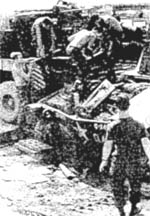 |
 |
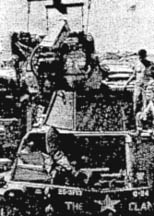 |
 |
DYNAMIC DISMANTLING - Removing the power pack - both engine
and transmission - of this M-109 self-propelled 155mm howitzer is part of the
regular quarterly preventive maintenance for such artillery pieces. This
405-horsepower V-8 diesel engine can be removed in about an hour by the crack 3d
Battalion, 13th Artillery Battalion maintenance crew. The preventive
maintenance routine then covers cleaning, tightening, adjusting and replacing
external engine parts, a process that can be completed in 24 hours. Minor
emergency repairs can be done in four hours or less. (PHOTOS BY SP4 PAT
MORRISON)
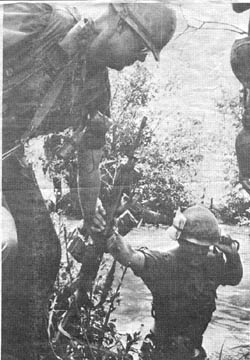 |
NEED A LIFT? - First Lieutenant Charles R. Viola of Sebastoph, Calif., offers a helping hand to Specialist 4 Harold Gravely of St. Clair, Mich., as Bravo Company, 2d Battalion, 14th Infantry crosses a canal while sweeping northeast of Trung Lap. (PHOTO BY 5P4 DAN ZALDIVAR) |
Swamp Buggies Bug Cong
By PFC Phil Jackson
CU CHI - Splashing through a marsh southwest of Trang Bang aboard
swamp boats, a combined 25th Division-Regional Forces unit cut another area off
the Viet Cong’s dwindling list of safe hiding places.
The unit included soldiers from Tropic Lightning’s Delta Company,
2d Battalion, 27th Infantry and 2d Battalion, 34th Armor, Vietnamese troops from
the 158th, 163d and 179th Regional Force companies, and a mobile strike force
from Tra Cu Special Forces Camp.
THE ALLIED force learned of enemy soldiers living in An Hung
village, 11 miles west of Cu Chi, at night and moving into the swamp to the east
during daylight hours.
“Every time we moved into the area the Viet Cong would scatter
into the swamp,” said First Lieutenant Philip Dean of Rochester, N.Y. “The enemy was always one step ahead and once he made it to the swamp, he
disappeared.”
The combined operation, however, took that extra step away from the
enemy. At 7:00 a.m., blocking forces moved into position on the western
end of the village, driving the VC into the swamp. Other allied elements
on the swamp’s eastern edge were waiting.
STOPPING SAMPANS and checking identification cards produced
nothing, so the command was given and the Allies’ boats sped deeper into the
swamp, beginning the laborious job of checking canal banks for possible hiding
places.
The Popular Forces came up with an AK-47 rifle and cleaning
equipment. Then Sergeant First Class Theotas Tucker of Muskegon Heights,
Mich., climbed on top of thick brush with a boost from a Popular Force soldier,
and found two anti-tank mines.
“It seems that the Viet Cong were using the top of the bush for a
trail and a hiding place,” Tucker said.
“WE MUST HAVE had Charlie really confused,” Specialist Four
Hector Aguirre of Mason, Mich., added. “A villager told us that three Viet
Cong ran out of the village and into the swamp earlier to avoid the Delta
Company blocking force. Later we received word that the 158th Regional
Force Company picked up three VC who stumbled out of the swamp.”
By the day’s end, the allies had gathered up one AK-50, an AK-47,
a B-12 anti-personnel mine, one 40-pound antitank mine, one 10-pound anti-tank
mine, a box of AK ammunition, five magazines, cleaning equipment and pots and
pans, along with three confused Viet Cong. The Viet Cong turned out to be
a hamlet chief, a squad leader for a local force, and a guerrilla.
Combined AP Outfoxes Foe
By SP4 Larry Goodson
FSB Pershing - A combined Vietnamese-American ambush patrol
outfoxed a Viet Cong force recently and wound up beating the enemy at his own
game.
The patrol made up of Fire Brigade soldiers from Alpha Company, 2d
Battalion, 12th Infantry, and men from the 36th Popular Force Platoon,
encountered the unknown sized enemy force two miles northeast of Trang Bang.
The Allies were moving along highway 6A and were approximately 250
meters from the scheduled ambush site when, as Platoon Sergeant Bruce D.
Holzhauer recalled it, “Charlie opened up where they thought we were.”
The patrol had just turned and was moving through open rice paddies
when the enemy put it’s firepower on the road where the Warriors and
Vietnamese had just been walking.
Private First Class Clyde Glover of Johnson City, Tenn., said,
“Everybody was already on line. All we had to do was get down and return
the fire.
A sweep of the area later confirmed that four enemy had been
killed.
Old Mortars Never Die, They Just Fire Away
CU CHI - There is a famous trite expression about old soldiers
fading away. But what about old mortar tubes?
Echo Company, 2d Battalion, 14th Infantry recently retired one of
its 4.2-inch mortars.
The gun was located at Fire Support Base Patton II. The last
round was sent on its way by Specialists 4 Robert Redmond of Mobile, Ala. and
Gerald Anderson of Pepin, Wis. They were assisted by Privates First Class
John Staige of Minneapolis, Minn., and Alfred Haraguchi of Hilo, Hawaii.
The tube’s last “Fire Mission” was called on a bright sunny
morning as the gunner dropped the 20,000th round down the tube. The round
was on its way and another vital piece of equipment had expended its life span.
“In accordance with Army regulations, the gun had to be retired
after 20,000 rounds had been fired from it,” said First Sergeant John R.
Putman of Willingboro, N.J.
“We have been firing this gun since August of 1968. It took
a little more than a full year to fire the maximum,” said Putman.
| THERE SHE GOES - As the “2” on the 20,000th round disappears into the retiring 4.2-inch mortar tube, Specialist 4 Gerald Anderson of Pepin, Wis., reaches for his ears to protect them from the last blast. Private First Class John Staige of Minneapolis, Minn., and Specialist 4 Robert Redmond of Mobile, Ala., are already prepared. (PHOTO BY SP4 FRANK DITTO) | 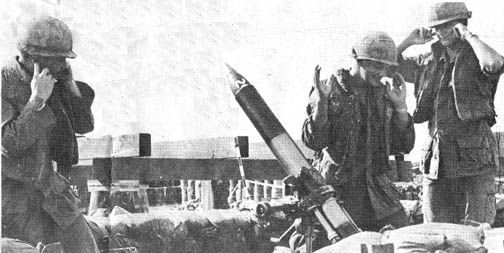 |
Page 4-5 TROPIC LIGHTNING NEWS September 22, 1969
2/34 Makes Craggy Slopes Craggier
Dreadnaught Armor Stalks the Black Virgin
|
Photo Feature By SP4 Carl Detrick |
 |
POINT MAN - A tank from Alpha Company, 2d Battalion, 34th Armor, leads a dreadnought convoy on an assault during the 1st Brigade operation. |
| RESUPPLY - A tanker totes 90mm cannon rounds to resupply his tank’s arsenal during a Tropic Lightning operation. | 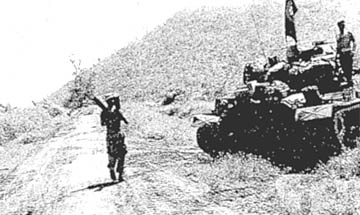 |
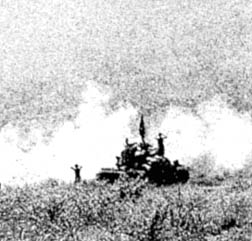 |
BRINGING SMOKE - Dreadnaught tankers from Headquarters company adjust 90mm cannon fire onto suspected enemy positions at the base of Nui Ba Den during a reconnaissance-in-force mission. |
| HANG ONE! - A mortarman “hangs” a 4.2-inch mortar round in preparation to fire on enemy emplacements on the slopes of Nui Ba Den. |  |
 |
ALERT - A recon squad from Headquarters Company stays alert while moving through the banana groves at the base of the Black Virgin Mountain north of Tay Ninh. |
| RUMBLIN’ DOWN THAT LONESOME ROAD, a Dreadnaught Tank secures the area around Nui Ba Den. |  |
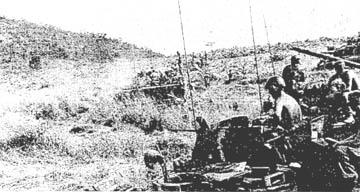 |
TIME OUT - Break time between assaults on Nui Ba Den allows a moment for checking weapons and preparing for the next volley of rounds to be thrown at the mountain. |
| PATROL - An Alpha Company tank patrols the roads and terrain north of Tay Ninh. | 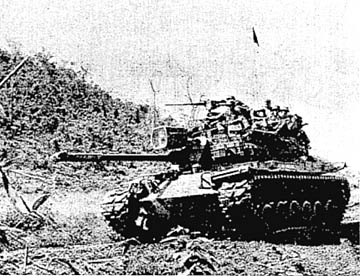 |
Page 6 TROPIC LIGHTNING NEWS September 22, 1969
MEDCAP Team Aids Villagers
By PFC Dennis Bries
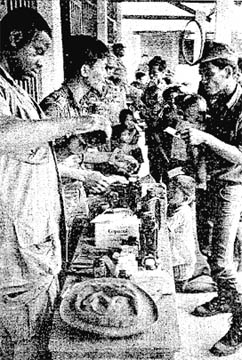 TAY NINH - Combined US-ARVN operations mean more than just combined
combat operations to the men of the 2d Battalion (Mechanized), 22d Infantry and
the 1st ARVN Airborne Battalion.
TAY NINH - Combined US-ARVN operations mean more than just combined
combat operations to the men of the 2d Battalion (Mechanized), 22d Infantry and
the 1st ARVN Airborne Battalion.
The ARVNs and Triple Deuce also undertake highly successful
combined medical civic action programs (MEDCAPs).
The MEDCAP team, directed by Captain Willie F. Black of Columbus,
Ga., has tried to improve the quality of the medical aid available to villagers.
The combined team treated 149 patients in the small village of Xom Ba recently.
The team has treated as many as 300 patients in one day in larger villages.
To handle this many patients the medical team needs the battalion
surgeon from the ARVN Battalion and two to four ARVN medics, along with
Specialist 4 Frankie G. Lane of Kansas City, Kan. chief medic for Triple Deuce.
To aid the organization and recording of illnesses treated, an
interpreter and an ARVN soldier register patients and send them to see the
doctor, who prescribes treatment. From there they are treated by medics or
receive the prescribed medication.
Black said, “We feel that the combined MEDCAPs have been very
successful because they not only cure the illnesses, they enable the people to
help themselves.”
WALK-IN DRUGSTORE - (Above right) Specialist 4 Frankie Lane of Kansas
City, Kan„ a medic with the 2d Battalion (Mechanized) 22nd Infantry, fills a
prescription while his counterpart medic from
the 1st ARVN Battalion explains the details of the medication to a little
girl’s father. The combined MEDCAP operation was held in the village of
Xom Ba, southeast of Tay Ninh. (PHOTO BY PFC DENNIS
BRIES)
 |
IMPERSONAL HYGIENE - Specialist 4 Ronald Knackstedt of Seattle, Wash., gives John, a mascot for Bravo Company, 2d Battalion, 27th Infantry Wolfhounds a morning bath in what might well be the world’s smallest bathtub. John doesn’t seem to have his heart in it, but caught in the grasp of a fellow Wolfhound, he patiently awaits getting out. (PHOTO BY PFC CRAIG SAMPSON) |
Warriors Occupy Booby Trap Garden
By SP4 Larry Goodson
CU CHI - Perhaps they should have named it Patrol Base Booby Trap,
in honor of its most common physical feature.
Warriors of the 2d Battalion, 12th Infantry were given the task of
constructing a new patrol base eight miles northwest of Cu Chi. The area
selected as the site has been known as a booby trap finder’s paradise.
SETTING OUT on the mission, infantrymen from Bravo Company didn’t
find anything until they arrived at the exact location of the future patrol
base.
Then, as Private First Class Ronnie L. Clark of Opelita, Ala.,
tells it, “There were booby traps, everywhere. I couldn’t believe
there were so many of them in such a small area.” At the end of the day,
69 booby traps had been found and disarmed.
Most were made of tin cans filled with explosives, nails, glass and
other materials that would cause casualties.
According to Private First Class Larry Marcum of Stirrat, W. Va.,
many of the traps were placed together in a line forming a barrier several
meters long.
“MOST OF THE trip wires were five feet long or less,” Marcum
said. “In most cases the wires were tied to a bamboo stake less than six
inches above ground and fixed to a grenade-type detonator placed in the buried
charge.”
Sharp-eyed infantrymen were aided by mine detectors in their
efforts to uncover the well-concealed traps.
Private First Class Mark J. Garcia of Monticello, Calif., described
his role in the operation. “I used a mine detector and found quite a few
traps. The grass was very tall, sometimes up to my waist. It was almost
impossible to spot them all.”
When the area was finally cleared, the 2d Brigade soldiers were
ready to begin construction of the patrol base, named Lorence in honor of
Specialist 4 John E. Lorence, a 2/12 infantryman killed in recent action.
Page 7 TROPIC LIGHTNING NEWS September 22, 1969
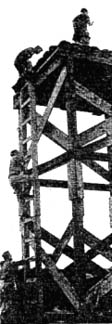 |
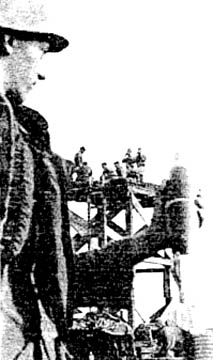 |
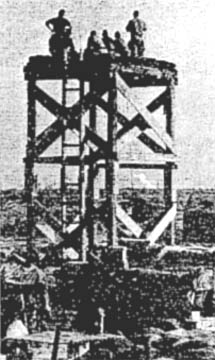 |
FIRE-POWER DEMONSTRATION - B-52 crew members touring the 2d Brigade’s operations area watch a firepower demonstration at Patrol Base Hunsley. After climbing the base’s 30-foot observation tower, the airmen watched with interest - and cameras ready - as Private First Class Lyle Thomason of Dearborn Heights, Mich., a mortarman with C Company, 2d Battalion, 14th Infantry, prepared to drop a round into his weapon. Then they saw the strike of a white phosphorous marking round, pinpointing the spot where a barrage of artillery and mortar fire hit seconds later.
Airmen Visit Infantry
B-52 Crew Gets Down to Earth View
CU CHI - In a day of whirlwind activity here recently a five man
B-52 crew from March Air Force Base, Calif., got a firsthand look at the war as
it’s seen by ground troops in Vietnam.
“It really looks different from this altitude, said Captain
Robert G. Scheffel of Williston Park, N.Y., as he flew over the Tropic
Lightning’s 2d Brigade area in a Little Bear chopper. “We’re usually
at 30,000 feet.”
It was the first helicopter ride for four of the men. Fire
Support Base Patton was the first stop, where the airmen visited the 2d
Battalion, 14th Infantry’s forward tactical operation center and were given a
155mm self-propelled howitzer firing demonstration put on by Alpha Battery, 3d
Battalion, 13th Artillery.
From Patton the men were flown to Patrol Base Hunsley.
Artillerymen, infantrymen, and mortarmen there combined to put on a show of
Tropic Lightning firepower.
The 3d Squadron, 4th Cavalry was on hand to show the Air Force how
a Army hunter-killer team operates. The men were also introduced to
weapons used by individual infantrymen, including M-60 machineguns, M-79 grenade
launchers and M-16’s.
The short trip back to Cu Chi was followed by a visit to the 3/4
Cav area, where the men saw the armament of Centaur LOH’s and Huey Cobras.
Several of the crewmen also got a chance to take a closer look at helicopters -
from the co-pilots seat at 1000 feet.
Upon their return to 2d Brigade headquarters, the airmen were
presented with a captured AK-47 by Colonel H.S. Long, Fire Brigade Commander
from Galatin, Mo.
“It’s going to be mounted on the wall back at our squadron,”
said First Lieutenant Russell L. Ware, of Bristol, Va.
“It was an impressive day,” commented Captain Guy Buesxing of
Monmouth, N.J., “but it was all too short.”
“The demonstrations made me appreciate more how ground troops
fight,” Scheffel said. “I’ve nothing but respect for the men on the
ground and in the helicopters.”
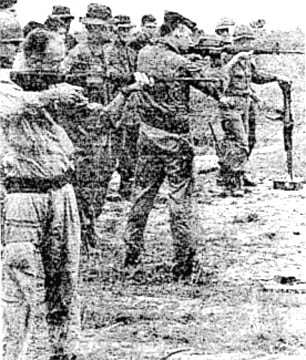 |
Two Air Force officers, First Lieutenant Russell L. Ware of Bristol, Va. (left), and Captain Guy K. Buesing of Monmouth Beach, N.J. try their hands at M-16 marksmanship at Patrol Base Hunsley. |
| Fire Brigade Commander Colonel H. S. Long of Galatin, Mo., (second from left) presented the visiting airmen with a captured AK47 rifle. | 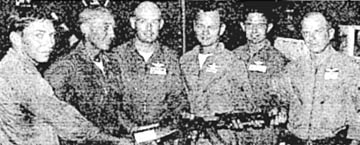 |
Page 8 TROPIC LIGHTNING NEWS September 22, 1969
Enemy loses 26 to Allies
Deuces Change NVA Morning Report
By SP4 Dennis J. Bries
TAY NINH - In a day-long battle against the NVA in a fortified
bunker complex, C Company, 2d Battalion (Mechanized), 22d Infantry, and the 73d
ARVN Airborne Company relieved the enemy of 26 of his soldiers, one detainee and
an assortment of weapons and web gear.
The action was part of continued US-ARVN operations in the Boi Loi
Woods, eight miles north of Trang Bang.
The Triple Duece Company had just begun the day’s sweep when they
were hit with small arms, RPG, and 51 caliber machinegun fire.
Captain Richard H. Goldsmith of Laramie, Wyo., C Company Commander,
said, “The men in the company did an excellent job of holding the contact
until supporting fires could be brought in.”
Before the day was over, such support included artillery from Fire
Support Bases’ Wood and Pershing, air strikes from the Air Force, and
helicopter light fire teams from Tay Ninh Base Camp.
“One man who did an especially outstanding job was our Third
Platoon Leader, Sergeant Keeno,” Goodsmith said.
Sergeant James Keeno of Myrtle Beach, S.C., the man Goldsmith
referred to, said, “I was the first one to get hit, but I decided to stay in
and fight despite my wound. Most of the men in my platoon are new in
country and I felt they needed me. The men did an outstanding job and
I’m recommending several of them for valorous awards.”
| A LUCKY ONE - The same artillery fire that flushed out the detainee being escorted here by two ARVN soldiers decimated an NVA force. The artillery was supporting the 73d ARVN Airborne and Tropic Lightning’s 2d Battalion, 22d Infantry, whose S-3 Air officer, Captain Thomas Casey, led the detainee to the POW debriefing area at Fire Support Base Wood III. (PHOTO BY SP4 DENNIS J. BRIES) | 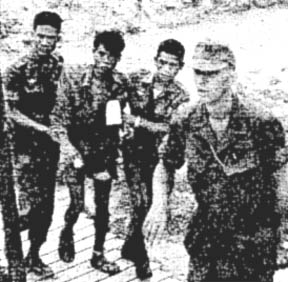 |
Dragons Trip Trap Makers
CU CHI - On a local sweep from Patrol Base Hunsley recently,
Charlie Company, 2d Battalion, 14th Infantry Golden Dragons found what looked
like a Viet Cong booby trap factory.
“We found this bunker-tunnel complex and the men started checking
the holes out,” said Captain Lewis Kasper of Rixey Villo, Va., “It wasn’t
long before they found a pile of explosives, along with detonating devices.”
The find included a handsaw, one pull-type detonator, 30 smoke
grenade fuzes, one AK-47 cleaning rod and 27 rounds of AK ammunition all of
which are used to construct and plant booby traps.
The explosive material discovered included two Chicom grenades, a
US Butterfly Bomb, two 82mm rounds, and two 75mm recoilless rifle rounds.
“This type of find helps to limit the VC supply and availability
of equipment. Viet Cong find it just a little harder to find this
equipment, especially when we start dropping artillery on this bunker complex
intermittently during the night,” added Kasper.
|
TRUSTING EYES - A young Vietnamese patient and her mother watch Army medic Private First Class James L. Tier of McLean, Va., as he treats sores on the little girl’s leg. Tier is part of a 3d Battalion, 13th Artillery Medical Civic Action Program team that makes weekly visits to villages in the Cu Chi area. (PHOTO BY SP4 PAT MORRISON)
|
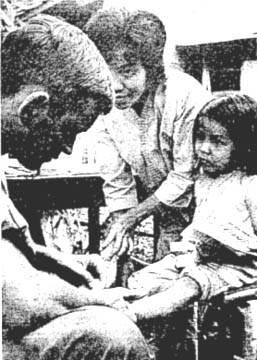 |
US-ARVN Team Nabs Mortar-Rocket Officer
By PFC Greg Stanmar
CU CHI - Two companies, one US, the other
ARVN, were sweeping an
area in the Fire Brigade’s sector near their laager site outside Fire Support
Base Hunsley.
Shortly after noon, a squad of the Vietnamese Company came alive.
They detected movement nearby and rushed to the suspected enemy location.
Minutes later they came back with one unharmed Viet Cong.
Later it was learned that the detainee was the commander of the
Eighth Artillery Battalion, responsible for keeping Sub-Region I, the 25th
Division’s area of operations, under mortar and rocket attack.
THE CAPTURE was only one instance of success Delta Company, 2d
Battalion, 14th Infantry and the company from the 2d Battalion, 49th ARVN
Regiment have had since teaming up to build the new hardspot.
“I think it’s a good company,” Private First Class Dale
Parrott, Walla Walla, Wash., said of the Vietnamese unit.
“We have some problem with the language barrier,” Specialist 4
Ronald Evans, Fall River, Mass., commented. “Often during an operation
it’s hard to get across who’s going to do what.”
HOWEVER, THERE was no language problem the night following the
capture of the VC battalion commander.
On that night ten ARVN soldiers and ten GIs were passing near a
village on their way to an ambush site when they passed 30 Viet Cong carrying
timber for their bunkers. The ambush patrol greeted the enemy unit with
the full volume of their small arms, creating grazing fire described by one
sergeant as “very effective.”
The result was six dead VC.
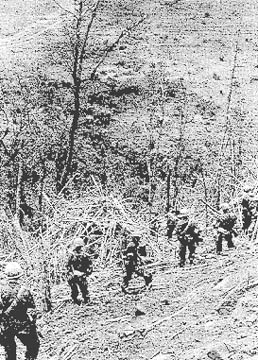 |
KINGS OF THE HILL - Soldiers of the 4th Battalion (Mechanized), 23d Infantry patrol on what has almost become part of their reservation, the slopes of Nui Ba Den. The Tomahawks killed more than 100 enemy soldiers on and near the mountain during the week that began Sept. 5. (PHOTO BY PFC SAM B. DIXON) |
Thanks to
Ron Leonard, 25th Aviation Bn., for locating and mailing this issue,
Kirk Ramsey, 2nd Bn., 14th Inf. for creating this page.
This page last modified 8-12-2004
©2004 25th Infantry Division Association. All rights reserved.